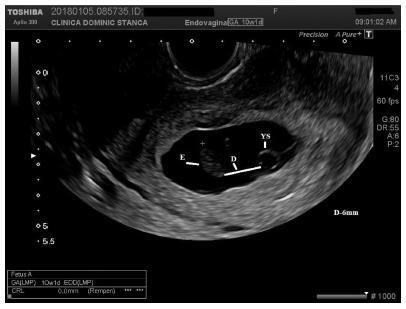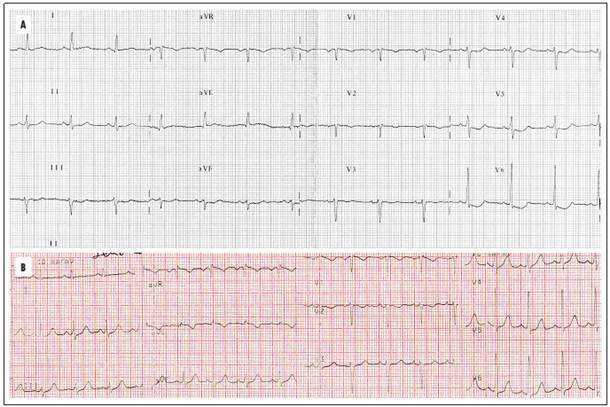Summary
Revista Brasileira de Ginecologia e Obstetrícia. 2019;41(9):525-530
The etiology of embryonic demise is multifactorial, with chromosomal abnormalities being the most common (40%). The purpose of the present study is to evaluate the correlation between a serum biomarker, progesterone, and an ultrasonographic parameter, the distance between yolk sac and embryo (DYSE) in assessing the prognosis of pregnancy outcome in the 1st trimester.
The present study is a prospective case-control analysis that includes 2 groups of patients: 81 patients with first-trimester normal evolutive pregnancy and 89 patients with embryonic demise, all of the patients having between 6 and 11 weeks of amenorrhea. Endovaginal ultrasonographic exploration was performed to evaluate the distance between the lower pole of the embryo and the yolk sac. From each subject enrolled in the study, 20ml of blood was collected for progesterone serum level measurement.
Regarding the DYSE in the case group, lower values were observed compared with the control group, the difference being statistically significant. In the statistical analysis of serum progesterone values, statistically significant differences were observed between the 2 groups (p<0.05).
The DYSE has a high positive predictive value in identifying pregnancies with potentially reserved outcome, with the present study demonstrating that a DYSE<3mm causes an unfavorable evolution of the pregnancy. Low serum levels of progesterone are associated with an increased rate of nonviable embryos. The correlation between these two parameters increases the effectiveness of screening methods in prenatal monitoring and improves the diagnostic methods for the firsttrimester pregnancies whose outcome potential can be reserved.

Summary
Revista Brasileira de Ginecologia e Obstetrícia. 2015;37(11):526-532
DOI 10.1590/SO100-720320150005391
Takotsubo cardiomyopathy is characterized by acute and transient dysfunction of the apical segment of the left ventricle usually after an intense physical or emotional stress, mimicking an acute coronary syndrome. Because this is a rare syndrome, the differential diagnosis is particularly important and a high level of suspicion is essential. Obstetricians should be aware to diagnose and deal with this unexpected event. Treatment is essentially supportive, with spontaneous and complete reversal of the changes within days or weeks. The occurrence of complications may dictate a less benign prognosis. We report a case of Takotsubo cardiomyopathy in a 39-year-old woman who underwent Cesarean delivery. She presented with bradycardia, chest pain and pulmonary edema immediately after the delivery. Her echocardiography showed and apical ballooning. Cardiac biomarkers and electrocardiogram were altered and echocardiogram showed severe left ventricular dysfunction with hypokinesia of the anterior wall. Coronary angiography excluded obstructive coronary artery disease.

Summary
Revista Brasileira de Ginecologia e Obstetrícia. 2014;36(11):527-528
Summary
Revista Brasileira de Ginecologia e Obstetrícia. 2018;40(9):527-533
Assisted reproduction combines innovative technologies and new forms of procreation through gamete donation; however, it also leads to moral and ethical issues and to the wide application of referential bioethics. The objective of the present study was to understand the bioethical context of shared oocyte donation.
The present qualitative study used the Collective Subject Discourse methodology to interview donors and recipients in Brazil.
Donors suffer from infertility, and in vitro fertilization opens the possibility of having a child; however, the cost is high, and helping the recipient is more important than the financial cost. The recipients regret delaying motherhood; adopting a child is their last option, and they desire to feel the physical stages of pregnancy. The recipients find the rules unfair regarding the lack of an oocyte bank and the fact that the treatment must be performed in shared cycles; however, oocyte donation makes it possible to realize the common dream of motherhood.
The obtained data showed that the patients are suffering and frustrated due to infertility, and they realize that in vitro fertilization may be the treatment they need. These women believe that children are essential in the constitution of the family, and scientific advances bring about innovative technologies and new forms of family constitution, with repercussions in the social, economic, political, and family contexts that lead to bioethical questions in Postmodernity.
Summary
Revista Brasileira de Ginecologia e Obstetrícia. 2002;24(8):527-533
DOI 10.1590/S0100-72032002000800005
Purpose: to analyze the perinatal results of patients submitted to a 100 g oral glucose tolerance test (OGTT) during prenatal care at the Instituto Materno-Infantil de Pernambuco (IMIP), according to three different criteria. Methods: a cross-sectional study was conducted involving 210 pregnant patients attended at the IMIP, who were tested by a 100 g OGTT and had a singleton, topic pregnancy, without history of diabetes or glucose intolerance before pregnancy, and who delivered at the IMIP. The patients were classified into one of the following categories according to the levels found by OGTT: controls, mild hyperglycemia, Bertini's group, Carpenter's group and the National Diabetes Data Group (NDDG). These classes were then compared and association between the categories and preeclampsia, large for gestational age (LGA) newborns, rate of cesarean delivery, stillbirth, and mean birth weight was investigated. Results: the frequency of gestational diabetes was 48.1, 18.1, and 9% according to Bertini's, Carpenter and Coustan's and NDDG criteria, respectively, and mild hyperglycemia was present in 10.5%. Age of patients increased with a higher degree of carbohydrate intolerance. The groups did not differ regarding frequency of LGA, C-section, stillbirths, and birth weight. There was an increased frequency of preeclampsia among women with hyperglycemia and gestational diabetes according to Carpenter and Coustan's criteria. Conclusions: prevalence of gestational diabetes varied between 9 and 48% according to the different criteria, but maternal and perinatal results did not differ significantly among the groups. Strict diagnostic criteria can determine overdiagnosis without improvement of perinatal outcome.
Summary
Revista Brasileira de Ginecologia e Obstetrícia. 1999;21(9):527-531
DOI 10.1590/S0100-72031999000900005
Purpose: to compare the efficacy and safety between two doses of intravaginal misoprostol for cervical ripening and induction of labor. Patients and Methods: sixty-one patients with medical indication for induction of labor and unfavorable cervix were included in this study. Twenty-eight of them received 25 µg and thirty-three 50 µg misoprostol, every four hours until delivery. Results: premature rupture of membranes, prolonged gestation and preeclampsia were the main indications for labor induction. The time interval, in minutes, from insertion of misoprostol until delivery was similar for the 25 µg (416.3 ± 148.1) and 50 µg (425.0 ± 135.9) groups. The percentage of vaginal delivery was 82.2% and 81.9% in the groups of 25µg and 50 µg, respectively. There was no significant difference between the two groups regarding fetal or maternal complications. Conclusions: the administration of intravaginal misoprostol was shown to be an efficient and safe method for cervical ripening and induction of labor. The dose of 25 µg was similarly effective and safe when compared to 50 µg.
Summary
Revista Brasileira de Ginecologia e Obstetrícia. 2004;26(7):527-533
DOI 10.1590/S0100-72032004000700004
PURPOSE: to evaluate the diagnostic accuracy of hysterosalpingography (HSG) and transvaginal sonography (TVS) in terms of detecting uterovaginal anomalies in women with a history of recurrent miscarriage. METHODS: eighty patients who presented two or more consecutive miscarriages were submitted to HSG, TVS and hysteroscopy (HSC). The following diagnoses were considered separately: uterine malformations, intrauterine adhesions and polypoid lesions. Hysteroscopy was the gold standard. The matching among the different methods was evaluated by the kappa coefficient and its significance was tested. The significance level was 0.05 (alpha=5%). Sensitivity, specificity, positive and negative predictive values, with 95% of statistical confidence interval, were calculated. RESULTS: uterovaginal anomalies were detected in 29 (36.3%) patients: 11 (13.7%) were uterine malformations, 17 (21.3%) intrauterine adhesions and one (1.3%) a polypoid lesion. The global matching between HSG and HSC was 85.5%, while between TVS and HSC it was only 78.7%. The best accuracy of HSG appeared to be for the diagnosis of uterine malformations and intrauterine adhesions (diagnostic accuracy of 97.5 and 95%, respectively). For the diagnosis of polypoid lesions, HSG had a diagnostic accuracy of only 92.5%, due to the low rate of positive predictive value (14.3%). TVS had a worse accuracy for all diagnoses, 93.7% for the diagnosis of uterine malformations and 85% for intrauterine adhesions, due to low sensitivity. CONCLUSIONS: histerosalpingography showed a good diagnostic accuracy for the diagnosis of uterine cavity diseases. TVS had good specificity, but with low sensitivity.
Summary
Revista Brasileira de Ginecologia e Obstetrícia. 2009;31(10):527-527